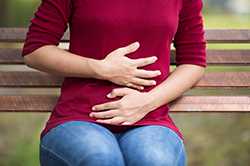Symptoms of Food Poisoning
Food poisoning symptoms may range from mild to severe and may differ depending on the germ you swallowed. The most common symptoms of food poisoning include:
- Upset stomach
- Stomach cramps
- Nausea
- Vomiting
- Diarrhea
- Fever

After you consume a contaminated food or drink, it may take hours or days before you develop symptoms.
Most people have only mild illnesses, lasting a few hours to several days. However, some develop severe illness requiring hospitalization, and some illnesses result in long-term health problems or even death. Infections transmitted by food can result in chronic arthritis, brain and nerve damage, and hemolytic uremic syndrome (HUS), which causes kidney failure.
Symptoms and Sources of Foodborne Illnesses
| Germ | Type | Typical Signs and Symptoms | Typical Time for Symptoms to Appear | Common Food Sources |
|---|---|---|---|---|
| Campylobacter | Bacteria | Diarrhea (often bloody), stomach cramps/pain, fever | 2 to 5 days |
|
| Clostridium botulinum | Bacteria | Symptoms start in the head and move down as severity increases. Symptoms include double vision, blurred vision, drooping eyelids, slurred speech, difficulty swallowing, dry mouth, muscle weakness, difficulty breathing and paralysis. | 18 to 36 hours |
|
| Clostridium perfringens | Bacteria | Diarrhea, stomach cramps. Vomiting and fever are uncommon | 6 to 24 hours (typically 8 to 12). The illness usually begins suddenly and lasts for less than 24 hours |
|
| Cyclospora | Parasite | Watery diarrhea, loss of appetite, weight loss, stomach cramps/pain, bloating, increased gas, nausea, and fatigue. Vomiting, body aches, headache, fever, and other flu-like symptoms may occur. | 1 week |
|
| Escherichia coli, Shiga toxin-producing, such as O157 | Bacteria | Severe stomach cramps, diarrhea (often bloody), and vomiting. If there is fever, usually it is less than 101˚F. Around 5-10% of people diagnosed with this infection develop a life-threatening complication called hemolytic uremic syndrome, a type of kidney failure. | 3 to 4 days after exposure, but may be as short as 1 day or long as 10 days |
|
| Listeria | Bacteria |
Pregnant women: Pregnant women typically experience only fever and other flu-like symptoms, such as fatigue and muscle aches. However, infections during pregnancy usually lead to miscarriage, stillbirth, premature delivery, or life-threatening infection of the newborn.
People other than pregnant women (most often adults aged 65 and older): Symptoms can include headache, stiff neck, confusion, loss of balance, and convulsions in addition to fever and muscle aches. |
1 to 4 weeks |
|
| Norovirus | Virus | Diarrhea, vomiting, nausea, stomach pain | 12 to 48 hours |
|
| Salmonella | Bacteria | Diarrhea, fever, stomach cramps, vomiting | 12 to 72 hours |
|
| Vibrio | Bacteria | Watery diarrhea, stomach cramps, nausea, vomiting, fever, and chills. | 24 hours |
|
If you believe you or someone you know got sick from food, even if you don’t know what food it was, please report it to your local health department. Reporting your illness may help public health officials identify a foodborne disease outbreak and keep others from getting sick.
When to See a Doctor
If you experience symptoms of food poisoning, such as diarrhea or vomiting, drink plenty of fluids to prevent dehydration.
See your doctor or healthcare provider if you have symptoms that are severe, including:
- High fever (temperature over 101.5°F, measured orally)
- Blood in stools
- Frequent vomiting that prevents keeping liquids down (which can lead to dehydration)
- Signs of dehydration, including a marked decrease in urination, a very dry mouth and throat, or feeling dizzy when standing up.
- Diarrhea that lasts more than 3 days

Groups More Likely to Get Food Poisoning
Anyone can get a foodborne illness, but people in certain groups are more likely to get sick and to have a more serious illness. These groups of people are:
- Children younger than 5 years
- Adults aged 65 and older
- People with immune systems weakened due to medical conditions such as diabetes, liver or kidney disease, alcoholism, and HIV/AIDS; or to receiving chemotherapy or radiation therapy.
- Pregnant women
If you or someone you care for has a greater chance of food poisoning, it’s especially important to take steps to prevent food poisoning and to know which foods are more associated with food poisoning than others.
Related Pages
- FoodSafety.gov: Who’s at Risk
- Page last reviewed: July 25, 2017
- Page last updated: August 31, 2017
- Content source:


 ShareCompartir
ShareCompartir